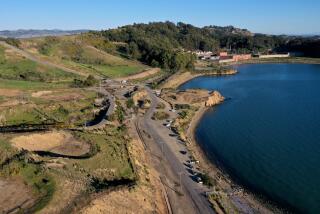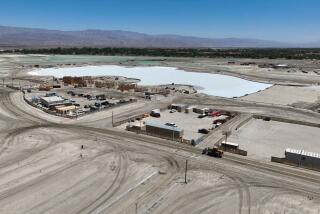Marina Development Plan Won’t Withstand Dilution
- Share via
Only a local population of residents will add the fabric necessary to have a true 24-hour-a-day city.
Much of San Diego has avoided the urban sprawl of Los Angeles by maintaining a sense of community. Although threatened with look-alike buildings and homogenized thinking, local identity and charm remain within the cafes of Hillcrest, the village of downtown La Jolla and the island flavor of Coronado.
Each neighborhood has developed its own atmosphere, defined its buildings, activities and people. Such a neighborhood, a very special one, may be emerging in the midst of downtown.
Picture a small, triangular parcel of land. To the north is the high-rise core of business; to the east, Horton Plaza and the historic Gaslamp Quarter. A view of San Diego Bay to the south is interrupted only by the Hotel Inter-Continental.
Sounds of a cruise ship leaving its terminal can be heard to the west. Wrapped in the renaissance of downtown redevelopment--the center of culture, the arts, government, transportation and business--this new community is known as the Marina redevelopment area.
Now an area with two housing projects amid parking lots and warehouses, Marina promises to be home to nearly 6,000 San Diegans.
This urban neighborhood will add what many are prepared to overlook in downtown: people with a sense of community, people who will participate in local activities, and people who will support businesses after 5 p.m.
Such a community is a cornerstone to the ultimate success of redevelopment.
Convention and tourist-related activities will add dollars to the city’s financial well-being.
Downtown offices ensure an active city full of people during daylight hours. However, only a local population of residents will add the fabric necessary to have a true 24-hour-a-day city.
Championed by the Centre City Development Corp., an Urban Design Plan is being developed to establish guidelines for the development of the Marina area. Its goal is the creation of a vibrant, urban residential environment, and it addresses such questions as land use, pedestrian and vehicular traffic, open space, amenities and building design.
Whether this goal becomes reality is the concern of those now living in Marina’s first new housing, the 442 condominiums at Marina Park and Park Row.
Willing to take a chance on downtown redevelopment, those homeowners have made a very real financial and emotional commitment. Casting aside suburban-minded fears--”Where do you shop?” and “What about transients?”--homes were purchased and families were moved. Finding a unique urban setting close to the waterfront was the motivating factor for most.
Talk to residents of Marina and you will hear the spark of excitement when they discuss downtown. After all, they live in a special place. They are creating a new neighborhood.
Talk to residents about the Urban Design Plan proposed by CCDC and they feel threatened. Not about the plan, but about its prospects for approval. Landowners, well-financed development interests, members of the City Council and, perhaps, several members of CCDC’s own board, seem determined to either cast aside or significantly dilute many of the plan’s attributes.
A key objective of the Urban Design Plan is to preserve waterfront views and access to the bay.
Unfortunately, the San Diego Unified Port District, just outside the reach of the city’s redevelopment agency, has already started a curtain of buildings, calculated to wall off the waterfront. The convention center and soon-to-be-finished twin towers of the Inter-Continental and upcoming Hyatt Regency represent monuments to bad planning.
Santa Fe Industries has used its position as the major private landowner in Marina to exclude an entire block from the plan, so it can build a high-rise hotel.
Also outside the plan’s scope, the Navy is likely to develop high-rise structures to the west. Bulky, massive or high-rise construction between the core business district and the waterfront simply cannot be allowed to continue.
Another goal of the plan is to encourage conventioneers, tourists and residents to leave their cars and enjoy a pleasant stroll through city streets.
Well-landscaped sidewalks lined with small shops and outdoor restaurants will help. The plan calls for buildings to be visually attractive at the street level and to include awnings and canopies, arcades and detailed architectural features. Requiring that new hotels be built north of Broadway will encourage visitors to discover our new city while walking to the nearby convention center.
Within the Marina redevelopment area, the City of San Diego has the opportunity to create a vibrant, people-oriented neighborhood. At a cost of $250,000, design consultants have shaped a set of guidelines intended to achieve this goal. Guidelines and recommendations, however, are only an indication of what we can accomplish. They speak of our intentions and our dreams.
To embrace these guidelines without strict implementation and enforcement is an empty cause. An attempt to dilute the plan under the guise of flexibility is an illusion.
Our civic leaders need to take a firm stand and to adopt this plan without compromise. Only with such commitment will Marina become a reality.
More to Read
Sign up for Essential California
The most important California stories and recommendations in your inbox every morning.
You may occasionally receive promotional content from the Los Angeles Times.










